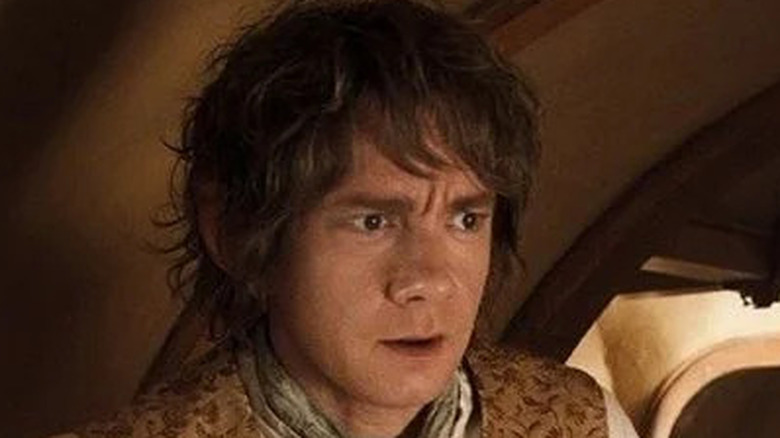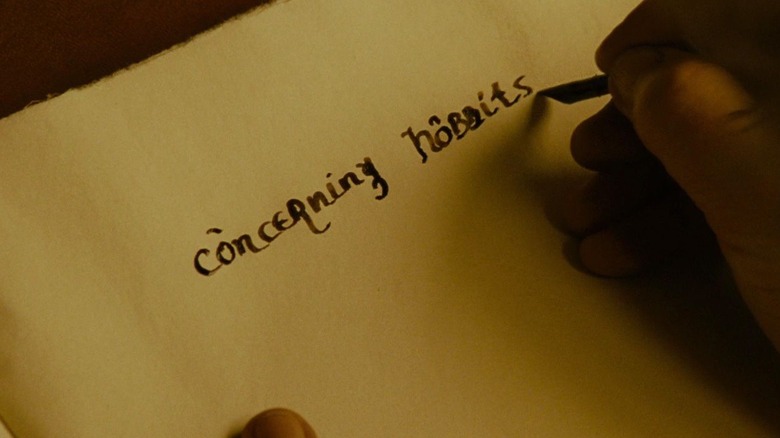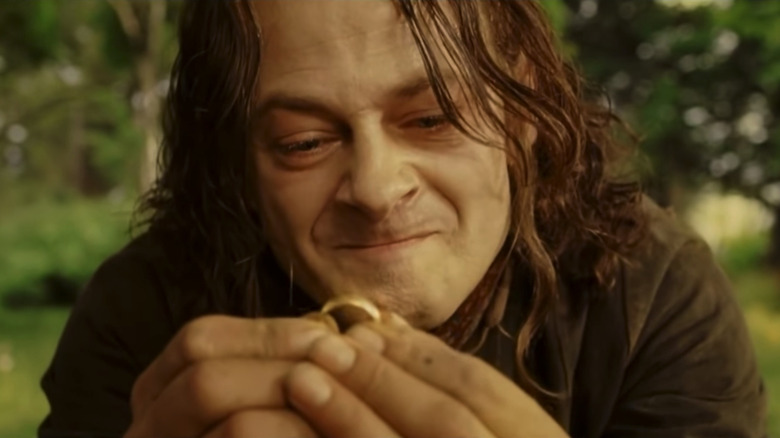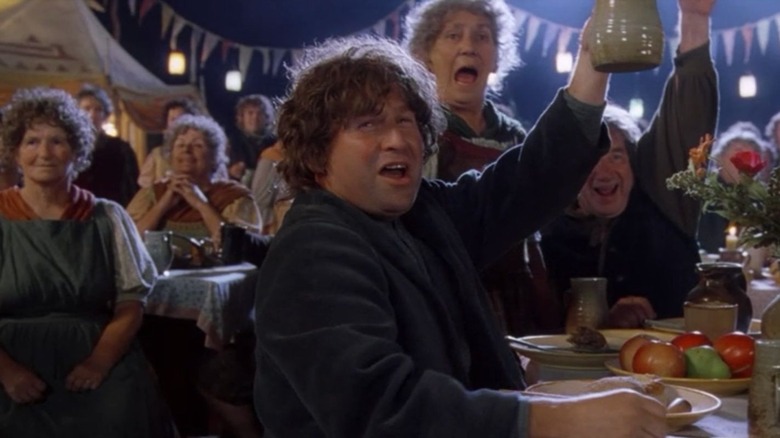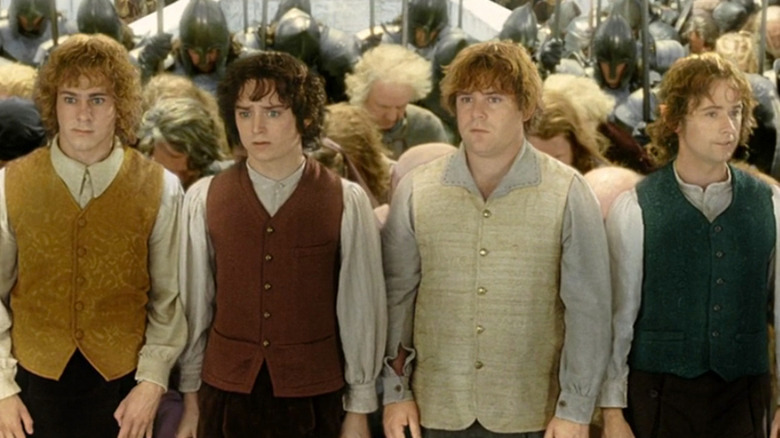How Halflings Could Factor Into Amazon's Middle-Earth Show
There's no doubt that Amazon's Middle-earth foray is going to be sailing in uncharted waters. Other Tolkienian projects are sticking closer to home — like Warner Animation and New Line Cinema's upcoming film "The War of the Rohirrim." While that project is set a mere 250 years before the LotR narrative, Amazon's show will be going back to the Second Age, which starts nearly 10,000 years before the One Ring goes into the fires of Mount Doom.
This is exciting in the sense that Amazon has a lot of creative liberty to build its own complementary version of Middle-earth. This will go alongside — rather than be in competition with — Peter Jackson's venerated trilogy. Renowned Tolkien scholar Tom Shippey, who has worked on the Amazon project, has even pointed out that, while it's a bit of a minefield, having the show focus on the Second Age means "You have to tread very carefully but at the same time there is quite a lot of scope for interpretation and free invention."
However, the placement of Amazon's story in the larger scope of Middle-earth history poses some interesting challenges. High on the list of priorities is finding ways to help mainstream audiences who haven't read the books connect to the new material. There are some immortal characters like Sauron, Galadriel, and Elrond who will be able to show up in the new production, but the bulk of the other familiar faces won't enter into existence for thousands of years.
One area where Amazon Studios appears to be both addressing this issue and flexing that "interpretation and free invention" is with Hobbits. In a recent Spy Report from fansite TheOneRing.net, it was shared that "Halflings" and "dark skin precursors to Shire-hobbits" would factor into the production of Amazon's show.
Using Hobbits to expand casting options?
Over the years, there has been no lack of accusations against Peter Jackson's original trilogy for being "whitewashed." It's a culturally sensitive area of concern that Amazon would understandably be keen to address in its own iteration of Middle-earth. The problem arises when one considers the fact that Tolkien's Middle-earth is supposed to play out as an Anglo-Saxon mythology. For instance, in a letter to an unidentified reader in 1956, the author explained that he had set himself a task "to restore to the English an epic tradition and present them with a mythology of their own."
The English inspiration at least makes the subsequent northern European-focused castings understandable. However, as it has dug through the source material, Amazon may have found an ideal way to expand the ethnicity of its cast — and without making every non-European actor play a role as an evil "Easterling" from the east or one of the cruel "Haradrim" from the south. This comes via Hobbits, a lovably heroic people group that was wholly made up by Tolkien himself.
In his fictional histories, Tolkien describes Hobbits as having darker skin when compared to the Elves or the lighter-toned men of Gondor and Rohan. In the prologue to "The Fellowship of the Ring," he specifically describes some of the Hobbit ancestors, particularly a group known as the Harfoots, as "browner of skin." This leaves the door open for creative liberty, which the studio appears to be embracing. The full leak from the Spy Report already mentioned explains that "Some Halflings are dark skin precursors to Shire-hobbits quite possibly 'one of three somewhat different breeds' maybe Harfoots." It also adds that English actor Sir Lenny Henry, who is already slated to show up in multiple episodes of the show, "portrays one such early halfling."
The Three "Breeds" of Hobbits
Another element that could diversify the representation of Hobbits a bit is the fact that Tolkien divides pre-Shire Hobbits into three different groups. These are the Stoors, the Fallohides, and the already mentioned Harfoots. These groups are all Halflings, but they have different characteristics.
For instance, the Stoors associate with Men, like water, and are heavy-set Hobbits. Gollum is supposedly an ancestor of the Stoors. In comparison, the Fallohides live in woodlands and connect with Elves more often. The Harfoots don't grow beards or use shoes. They are known for their dexterity, live in tunnels in hillsides, and like the Dwarves. They're also the most common of the three groups.
Now, technically speaking, these three groups are only talked about during the Third Age. So, there's a good chance that we won't see an official "Harfoot Hobbit" in Amazon's show. Instead, what we're more likely to see are ancient ancestors of these three groups of Halflings, and it appears that, based on the information available so far, the show is going to focus on the Harfoot model for the earlier precursors of the Hobbit race.
How could Hobbits impact Amazon's story?
The idea of Hobbits in Amazon's show poses another interesting quandary that has to do with timing. See, Tolkien gives us next to nothing when it comes to Hobbit history before the Third Age. Fortunately, a quick look at some of the scraps of ancient Hobbit lore that we do have available can give us something to go on. Let's start by going back to the prologue to "The Fellowship of the Ring." In that opening salvo to "The Lord of the Rings" story, it's explained that "the beginning of Hobbits lies far back in the Elder Days that are now lost and forgotten."
The question is, what does "Elder Days" mean? It turns out that the term is defined in the Appendix of "The Return of the King," where it explains that "Elder Days" specifically describes "the days before the casting out of Morgoth." This refers to the original Dark Lord, who's given the boot at the end of the First Age. This opens up the doors for Sauron to take over in the Second Age, which also happens to be where Amazon's story will be focused.
Not only that, but the super-nerd book "The Peoples of Middle-Earth" tells us that "in their unrecorded past they must have been a primitive, indeed 'savage' people" — and yes, that means we could be in for some half-savage, wild Hobbits.
So, to recap, Hobbits are around during the Second Age, but their history is very hazy at that point. They're still pretty barbaric and we don't know where they live. They may have been divided into their three "breeds" at this point, but then again, they may not. It isn't until halfway through the Third Age, when they're living in the Shire, that the Hobbits' collective history becomes more clear. This gives the team over at Amazon a lot of leeway as they integrate the Little People into their show.
Hobbits and Men
Another important bit of Hobbit info dropped in "The Fellowship of the Ring" intro is the fact that they're related to Men. The book says that "It is plain indeed that in spite of later estrangement Hobbits are relatives of [Men]," even though it adds that the connection "can no longer be discovered." In "The Peoples of Middle-Earth" volume it also explains that, while they start savage, it's their relationship with their fellow Men that helps civilize them. They learn many arts and customs from Men, which slowly turns them into the calm, peaceful Shire-dwellers that we all know and love.
This connection to Men could play an integral part in Amazon's show. While we're just spit-balling, at this point, Amazon could use the relationship between the two related people groups in multiple ways. For instance, they could use groups like primitive Halflings and Tolkien's equally uncivilized wood people, the Drúedain, to highlight how tough life is in Middle-earth when the Second Age starts.
While it seems likely that Sauron won't even factor into the show for a while, there are plenty of other dangers lurking around the continent at this time. "The Silmarillion" tells us that many of the men of Middle-earth "were still wandering in the unharvested lands, wild and lawless." It also explains that "Men dwelt in darkness and were troubled by many evil things...Demons, and dragons, and misshapen beasts, and the unclean Orcs...And the lot of Men was unhappy."
If you count "Hobbits" alongside "Men," you've got a recipe for a very un-Shire-like, rough-and-tumble Hobbit story that could add a lot of unexpected drama into Amazon's show. The one thing we likely can't expect to see are the round doors, ordered dwellings, and all-around simple life of the Shire that has hitherto been synonymous with the term "Hobbit."
